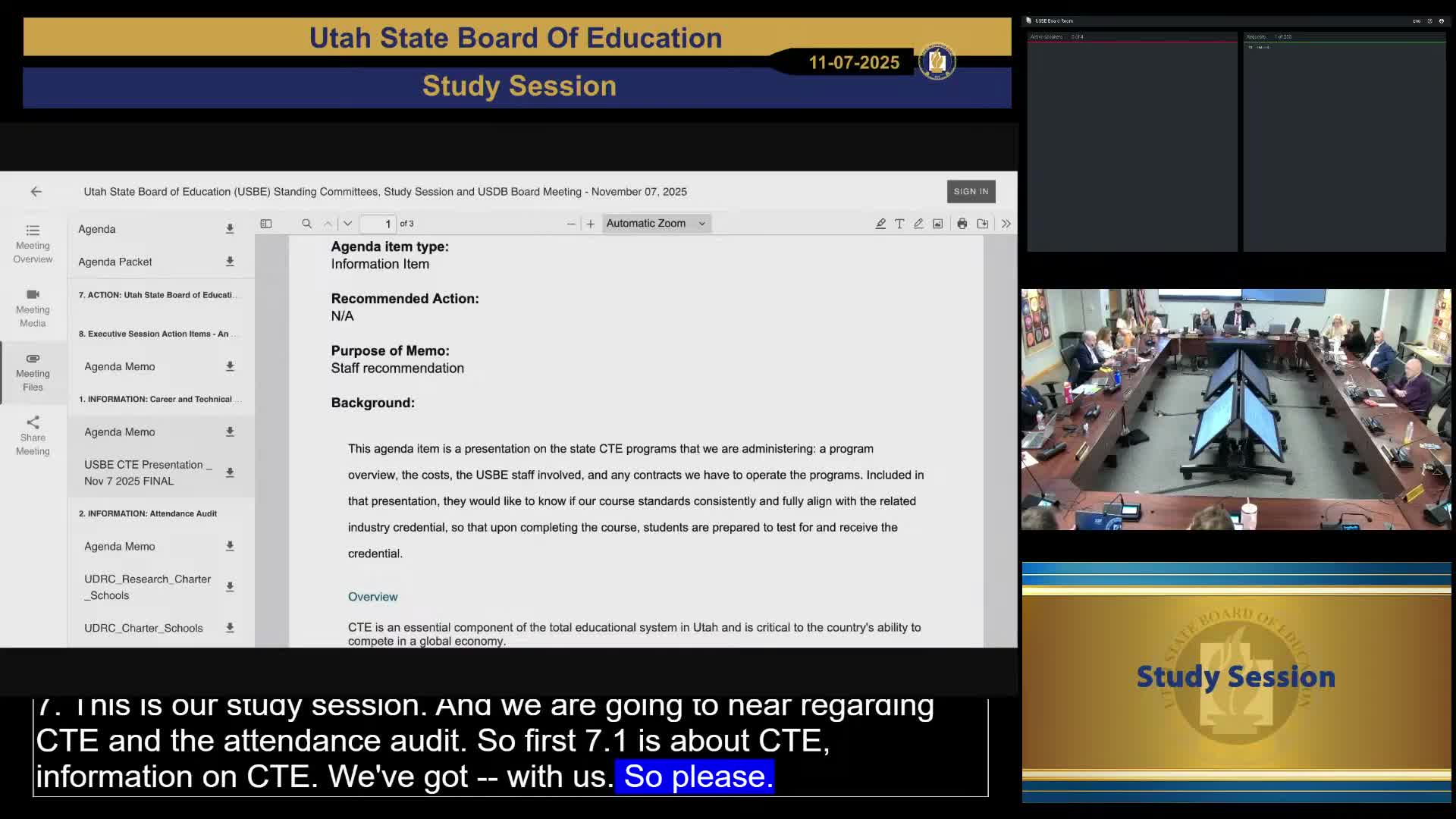State CTE director briefs board on pathways, funding and 'first credential' rules; master list for credentials pending
November 08, 2025 | Financial Operations , Utah Board of Education, Offices, Departments, and Divisions, Organizations, Utah Executive Branch, Utah
This article was created by AI summarizing key points discussed. AI makes mistakes, so for full details and context, please refer to the video of the full meeting. Please report any errors so we can fix them. Report an error »

The Utah State Board of Education received an informational briefing on Career and Technical Education (CTE) from State CTE Director Talia Longhurst and staff, who described statewide pathways, funding, credentialing and the new statutory 'first credential' framework.
Longhurst described CTE’s statewide structure: 14 career clusters and 32 state‑determined pathways aligned with postsecondary partners and regional planning. Utah requires a middle school college‑and‑career awareness course beginning in grade 7 and a one‑credit high‑school CTE graduation requirement. Longhurst said most students take CTE at their home high school; additional models include LEA‑run technical centers, a dedicated CTE high school in Washington County, and partnerships with postsecondary institutions.
Funding overview: Longhurst said Utah receives roughly $17.0 million in Perkins federal funds (85% flows to LEAs and postsecondary institutions) and an FY‑26 state CTE add‑on of about $130.0 million that flows 100% to LEAs with approved CTE programs. She noted the legislature removed a carve‑out that had previously funded college‑and‑career awareness and CTSOs; that change contributed to the FY‑26 decrease of a little over $500,000 in the state add‑on allocation.
First credential: Longhurst explained a new statute requires every high‑school student to have the opportunity to earn a meaningful industry‑aligned “first credential” through one of five routes. One route is a youth apprenticeship of approximately 300 hours; other routes include postsecondary programs and industry‑recognized credentials. Longhurst and staff said the master list of qualifying credentials and related guidance will be developed after the master plan and will be presented for broader review.
CTSOs and credentials: Longhurst highlighted that Career and Technical Student Organizations (CTSOs) are cocurricular and participated by tens of thousands of students; USBE historically received about $900,000 to manage and grant to those organizations. Board members raised concerns about CTSO funding reductions and asked how trade programs (automotive, HVAC, welding, electrical) are represented; staff said trades appear within the pathway and course lists and many programs partner with technical colleges for higher‑cost specialized instruction.
Why it matters: the briefing clarifies how CTE operates in Utah, the funding streams that sustain programs and the legislative effort to standardize a first meaningful credential for all high‑school graduates. Board members asked for follow‑up on credential master‑list development, CTSO support, and the timeline for funding model changes tied to working‑group recommendations.
Speakers: Talia Longhurst (state director of CTE), Wendy Morton and Jonathan Frey (CT coordinators) and several board members including Member Carey, Member Booth, Member Brinton and Member Kelly.
Provenance (transcript evidence): presentation start — Longhurst: “My name is Talia Longhurst. I'm the state director of career and technical education.” (tc 01:19:04); first‑credential discussion and apprenticeship hours — “There are 5 routes…one is 300 hours of a youth apprenticeship.” (tc 01:33:15).
Longhurst described CTE’s statewide structure: 14 career clusters and 32 state‑determined pathways aligned with postsecondary partners and regional planning. Utah requires a middle school college‑and‑career awareness course beginning in grade 7 and a one‑credit high‑school CTE graduation requirement. Longhurst said most students take CTE at their home high school; additional models include LEA‑run technical centers, a dedicated CTE high school in Washington County, and partnerships with postsecondary institutions.
Funding overview: Longhurst said Utah receives roughly $17.0 million in Perkins federal funds (85% flows to LEAs and postsecondary institutions) and an FY‑26 state CTE add‑on of about $130.0 million that flows 100% to LEAs with approved CTE programs. She noted the legislature removed a carve‑out that had previously funded college‑and‑career awareness and CTSOs; that change contributed to the FY‑26 decrease of a little over $500,000 in the state add‑on allocation.
First credential: Longhurst explained a new statute requires every high‑school student to have the opportunity to earn a meaningful industry‑aligned “first credential” through one of five routes. One route is a youth apprenticeship of approximately 300 hours; other routes include postsecondary programs and industry‑recognized credentials. Longhurst and staff said the master list of qualifying credentials and related guidance will be developed after the master plan and will be presented for broader review.
CTSOs and credentials: Longhurst highlighted that Career and Technical Student Organizations (CTSOs) are cocurricular and participated by tens of thousands of students; USBE historically received about $900,000 to manage and grant to those organizations. Board members raised concerns about CTSO funding reductions and asked how trade programs (automotive, HVAC, welding, electrical) are represented; staff said trades appear within the pathway and course lists and many programs partner with technical colleges for higher‑cost specialized instruction.
Why it matters: the briefing clarifies how CTE operates in Utah, the funding streams that sustain programs and the legislative effort to standardize a first meaningful credential for all high‑school graduates. Board members asked for follow‑up on credential master‑list development, CTSO support, and the timeline for funding model changes tied to working‑group recommendations.
Speakers: Talia Longhurst (state director of CTE), Wendy Morton and Jonathan Frey (CT coordinators) and several board members including Member Carey, Member Booth, Member Brinton and Member Kelly.
Provenance (transcript evidence): presentation start — Longhurst: “My name is Talia Longhurst. I'm the state director of career and technical education.” (tc 01:19:04); first‑credential discussion and apprenticeship hours — “There are 5 routes…one is 300 hours of a youth apprenticeship.” (tc 01:33:15).
View full meeting
This article is based on a recent meeting—watch the full video and explore the complete transcript for deeper insights into the discussion.
View full meeting

